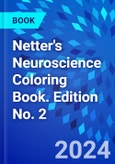Reinforce your knowledge of neuroanatomy, neuroscience, and common neurologic disorders with this active, engaging, and relaxing review method! Netter's Neuroscience Coloring Book, 2nd Edition, makes abstract concepts more concrete as you use color and tactile movement to reinforce your memory and understanding of the brain, spinal cord, and peripheral nervous system. It's a fun and interactive way to learn and review a complex but fascinating subject-whether you're taking a course in neuroscience, preparing for a neuroscience program, or planning a career in research, science, or medicine and healthcare.
More than "just� a coloring book, this unique learning tool offers:
More than "just� a coloring book, this unique learning tool offers:
- More than 145 key topics in neuroscience and neuroanatomy, using bold, clear drawings based on classic Netter art.
- Coloring exercises for visual and tactile learning as you trace pathways and tracts, reinforcing spatial, functional, and clinical concepts in this fascinating field.
- A clear organization with 4 major sections: (1) Overview of the nervous system; (2) regional neuroscience; (3) systemic neuroscience; and (4) global neuroscience.
- Three major components for each topic and accompanying illustrations: What is it and what does it do?; Color the most important structures; and What is the functional and clinical significance?
- Text revision based on extensive student feedback.
- New coloring exercises on Endogenous Opioid Systems, Insular Cortex, Prefrontal Cortex, Dementias, Alzheimer's Disease, Posttraumatic Stress, Traumatic Brain Injury (TBI), and Brain Substrates of Addictive Disorders.
- Clinical Notes that bridge basic science with health care and medicine.
Table of Contents
1 Neurons and Their Properties2 Brain, Skull, and Meninges
3 Brainstem, Cerebellum, and Spinal Cord
4 Ventricles, Cerebrospinal Fluid, and Vasculature
5 Peripheral Nervous System
6 Spinal Cord
7 Brainstem and Cerebellum
8 Forebrain: Diencephalon and Telencephalon
9 Sensory Systems
10 Motor Systems
11 Autonomic-Hypothalamic-Limbic Systems
12 Global Brain Functions and Disorders








